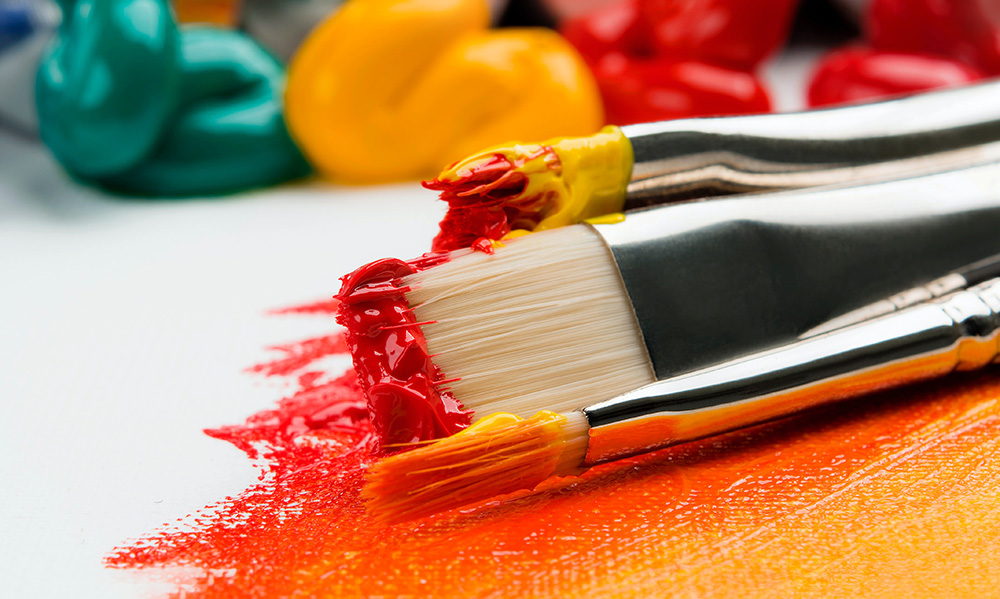Glazing is a technique used to build up many layers of color in a painting, creating a natural flow between two color tones. The first of the acrylic glazing techniques that we are going to look at is the medium based glazing. In this type of glazing you will mix your acrylic paint with a glazing medium that can be bought at most art supply stores.
This medium is a colorless gel that, when mixed in with your acrylic paint, will cause it to become transparent but keep the hue and saturation of the color intact. This method gives you total control of the coloration process and it is my favorite way of glazing.
The second of the acrylic glazing techniques is using water to dilute the paint down to a very thin state. Most acrylic paints found at art stores are opaque (it will be written on the tube whether it is opaque or not).
By mixing the paint with water at a 2 parts of water 1 part of paint ratio, you will find that the paint when applied appears to be translucent. If you begin to build up layers you will notice that you have full control of the hue and shade of the painting, just as long as you remember to let the different coatings dry up before applying the next one.
As you might have noticed there isn’t much rocket science involved in the two acrylic glazing techniques mentioned here. It is all just a matter of slowly building up thin coats of color. The glazing technique is often used in portraits and landscape paintings, where precise coloration and fine details are very important. For my own part I often use this technique for painting faces and skies or clouds.
As with any of the known acrylic painting techniques there is only one good way to learn this and that is learning by doing, and perhaps even failing a little bit. You don’t need a new canvas to test out the two acrylic glazing techniques described in this article. A regular piece of A4 paper will do just fine.
If you don’t know what to paint or where to begin, then simply start out with a thick blue line on the paper and try to grade its edges out into the white background of the paper. This will provide you with useful practice on how to glaze with acrylics and also the mixing rations that will work for you.
I hope this article has given you some insight into the two most common acrylic paint glazing techniques used, how you can start using them and where to apply them. Now to buy the best acrylic paints, visit TheReviewGurus.
Throw away your paintbrush and try some finger painting with acrylic paints. This way of painting is widely used among many popular artists, and for a good reason. As an artist you really want to become the best with your paint and the canvas. By using finger painting, you can achieve this quite easily. However, painting with your fingers will present you with some limitations at first as it can be difficult to find the right technique to create fine details, and to find the right mixture of acrylics and water. Here I will share my personal finger painting tips with you.
I often use two different techniques that vary depending of what kind of painting I am trying to make. When painting finer details I often make use of my little finger as it has the smallest surface area. If I need to do super fine details on the painting then I use my nails, but this of course can only be done if your nails are long enough.
I have found that an interesting method for making flowers, hair, grass and that sort of thing is making regular hand and fingerprints on the canvas. If applied correctly and many times on top of each other, then this finger painting method will give you an interesting result.
The water to paint ratio that is used is 1 part of water and 2 parts of acrylic paint. This makes the paint stick and prevents unwanted smears on the canvas, but this is just a guideline! If you are looking to create some sort of drip-effect then the ratio should be more like 2 parts of water per 1 part of paint.
Finger painting became famous after the American performance painter, Denny Dent, created fantastic portraits of pop icons just using his fingers and his energy. It was Denny Dent who inspired me to try out finger painting, and combining the intimate contact with the paint and canvas with the energy of music.
If you haven’t tried finger painting before then I would recommend that you start out with the water/paint mix ratio as mentioned before, using regular paper as canvas. There is no need to start out with a masterpiece project just yet. Spend some time just monkeying around with the paint and get to know how it reacts to your movements and what you can and can´t do with finger painting.
Keep in mind that acrylic paint is slightly toxic, so make sure to clean your fingers thoroughly once you are done painting. Also, don’t keep your hands soaked with paint for many hours at a time as it will give you a rash and I am saying it from my personal experience. Please, click here for more tips to use acrylic paints.





